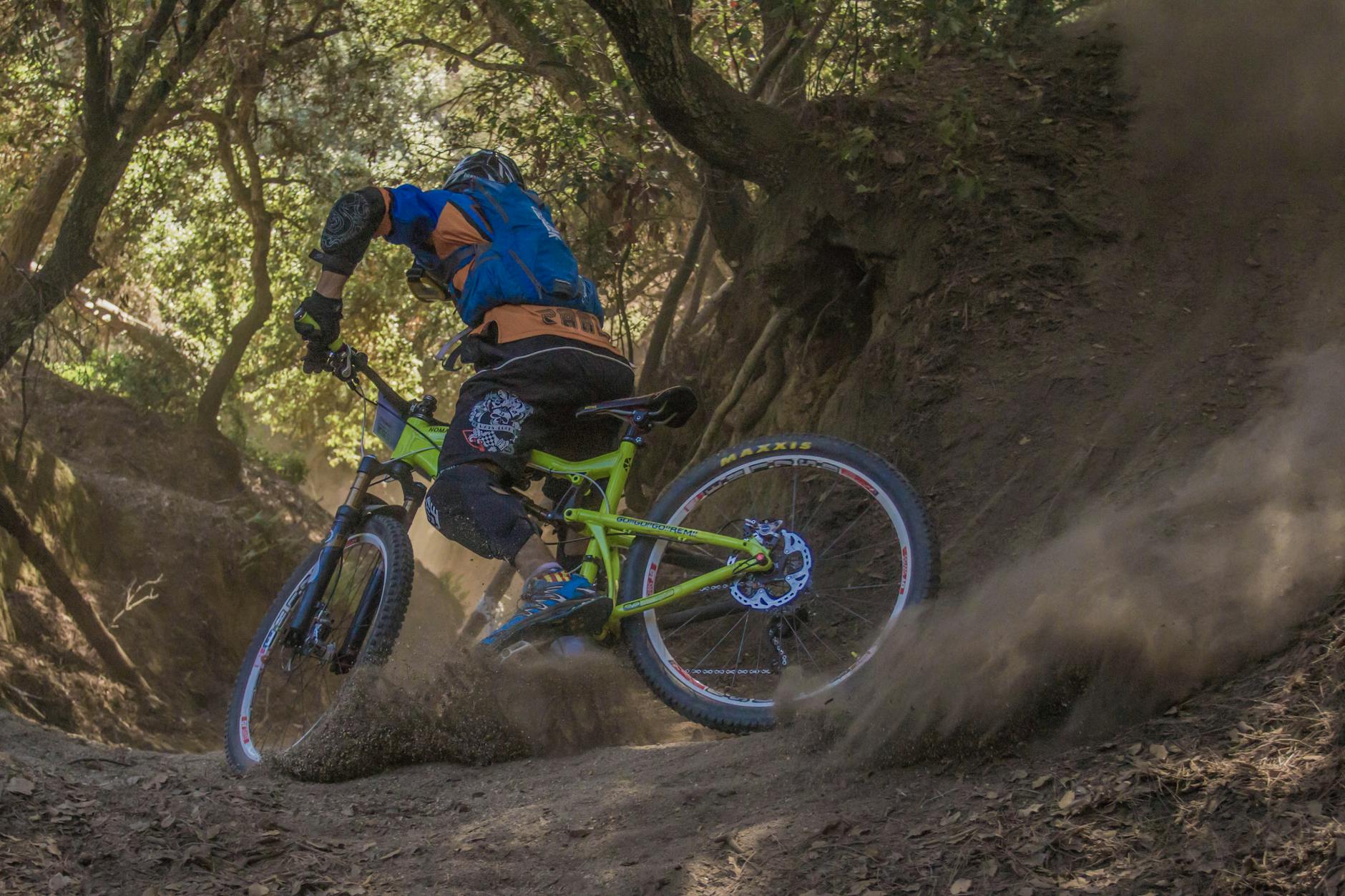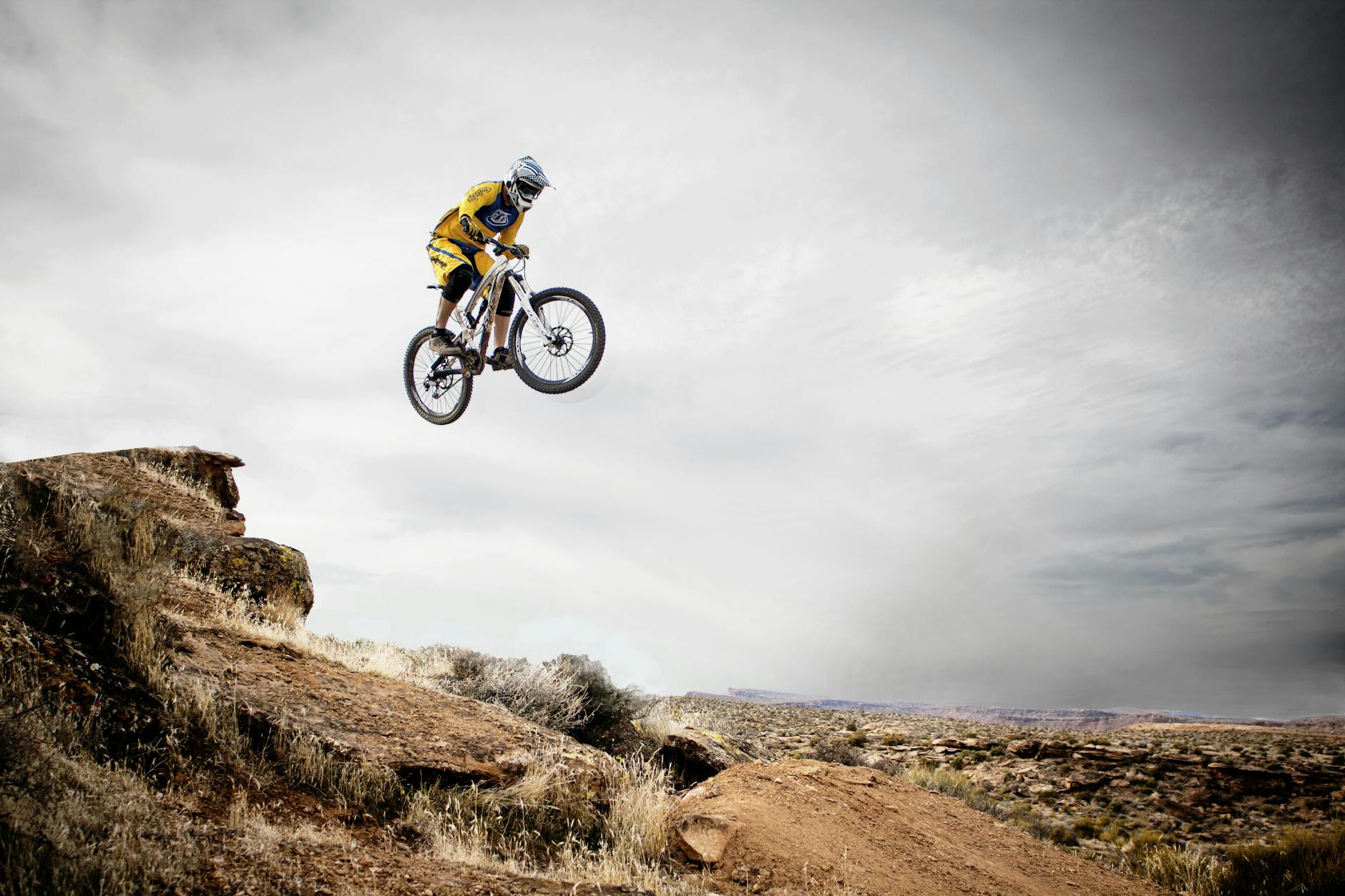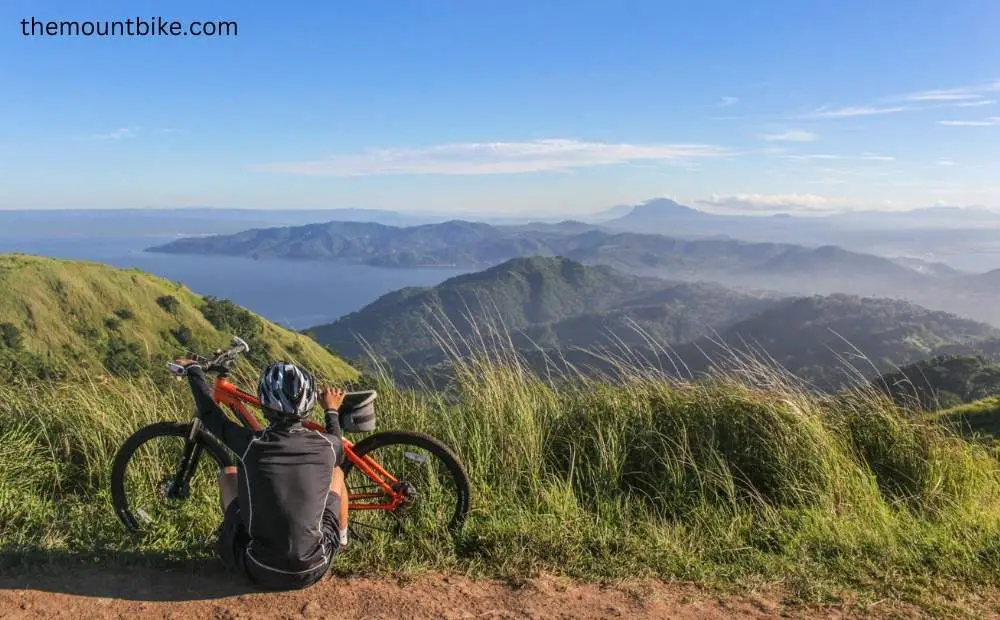Have you ever watched in awe as mountain bikers effortlessly spin their bikes mid-air, performing gravity-defying tricks? One of the most impressive and stylish moves in the mountain biking world is the tailwhip.
Mastering the tailwhip can take your riding skills to the next level, but it’s not without its challenges. Many riders struggle with the timing, coordination, and sheer courage required to pull off this trick. But fear not! Whether you’re a beginner looking to add some flair to your rides or an experienced rider aiming to perfect your technique, this guide will walk you through everything you need to know about tailwhipping a mountain bike.
From understanding the basics to exploring advanced variations, we’ll cover all aspects of the tailwhip. We’ll delve into the proper preparation, break down the fundamental technique, and highlight common mistakes to avoid. So, gear up and prepare to impress your fellow riders as we dive into the exhilarating world of mountain bike tailwhips!
Understanding the Tailwhip
Definition and Origin of the Tailwhip Trick
The tailwhip is an iconic trick in mountain biking and BMX riding where the rider spins the bike’s frame 360 degrees around the front wheel while airborne, catching it mid-rotation to land smoothly. This visually stunning maneuver originated in the BMX scene during the 1980s but has since become a staple in mountain biking, particularly in freestyle and dirt jump disciplines.
Why It’s a Popular Mountain Biking Move
The tailwhip has gained immense popularity among mountain bikers for several reasons:
- Visual appeal: The trick’s fluid motion and technical complexity make it a crowd-pleaser.
- Versatility: It can be performed on various terrains and obstacles.
- Skill demonstration: Mastering the tailwhip showcases a rider’s control and bike handling abilities.
- Progression potential: The basic tailwhip serves as a foundation for more advanced variations.
Skill Level Required
Performing a tailwhip on a mountain bike requires a combination of skills and prerequisites:
- Intermediate to advanced riding experience
- Strong bike control and balance
- Comfort with airtime and jumping
- Good core strength and coordination
Here’s a breakdown of the skill progression leading to the tailwhip:
| Skill Level | Prerequisite Tricks | Key Abilities |
|---|---|---|
| Beginner | Bunny hops, small jumps | Basic bike control |
| Intermediate | Larger jumps, 180° spins | Air awareness, rotation |
| Advanced | 360° spins, no-handers | Advanced bike manipulation |
| Expert | Tailwhips and variations | Precise timing, body control |
While the tailwhip is considered an advanced trick, riders can work towards it by gradually building their skills and confidence. It’s essential to approach the tailwhip with respect for its difficulty and to practice in a controlled environment with proper safety gear.
As we delve deeper into the world of tailwhips, it’s crucial to understand that mastering this trick requires dedication and proper preparation. In the next section, we’ll explore the necessary steps to prepare yourself and your bike for attempting this exhilarating maneuver.
Preparing for the Tailwhip
Now that we understand what a tailwhip is let’s dive into the essential preparations needed to execute this impressive mountain bike trick safely and effectively.
A. Necessary bike modifications
To perform a tailwhip on a mountain bike, you may need to adjust your ride. Here’s a list of modifications to consider:
- Lower your seat post for better maneuverability
- Adjust tire pressure for optimal grip and bounce
- Ensure your brakes are properly tuned
- Consider removing the front brake for easier rotation (advanced riders only)
B. Protective gear essentials
Safety should always be your top priority when attempting any mountain bike trick. Here’s a table of essential protective gear you should wear:
| Gear Item | Purpose |
|---|---|
| Full-face helmet | Protects your head and face from impacts |
| Knee pads | Guards against knee injuries during falls |
| Elbow pads | Prevents elbow scrapes and impacts |
| Gloves | Improves grip and protects hands |
| Shin guards | Shields shins from pedal strikes |
| Padded shorts | Cushions your hips and tailbone |
C. Choosing the right terrain
Selecting the appropriate terrain is crucial for practicing and perfecting your tailwhip. Consider these factors:
- Start with a flat, open area with a smooth surface
- Progress to small jumps or drops once you’re comfortable
- Look for areas with soft landings, such as dirt or grass
- Avoid crowded trails or areas with obstacles
D. Warming up exercises
Before attempting any tailwhips, it’s essential to warm up your body to prevent injuries and improve performance. Here’s a quick warm-up routine:
- Jumping jacks (2 sets of 20)
- Arm circles (forward and backward, 10 each direction)
- Leg swings (10 per leg)
- Light jogging in place (1 minute)
- Gentle stretches for your back, shoulders, and legs
By properly preparing your bike, wearing the right protective gear, choosing suitable terrain, and warming up your body, you’ll be setting yourself up for success in mastering the tailwhip technique. Remember, safety should always come first when attempting any mountain bike trick. With these preparations in place, you’ll be ready to move on to the basic tailwhip technique in the next section.

Mastering the Basic Technique
Now that you’ve prepared yourself and your bike, it’s time to dive into the core technique of performing a tailwhip on your mountain bike. This section will break down the fundamental steps to execute this impressive trick.
A. Proper Body Positioning
Correct body positioning is crucial for a successful tailwhip. As you approach the jump:
- Keep your body centered over the bike
- Bend your knees slightly for better shock absorption
- Hold the handlebars with a firm but relaxed grip
- Keep your eyes focused on the landing area
Remember, a balanced stance will give you better control throughout the trick.
B. Initiating the Spin
The key to a smooth tailwhip lies in the initiation. Here’s how to get that spin going:
- As you leave the lip of the jump, pull up slightly on the handlebars
- Use your dominant foot to kick the rear of the bike away from you
- Simultaneously, push the handlebars in the opposite direction of the kick
| Action | Timing | Purpose |
|---|---|---|
| Pull up handlebars | At jump takeoff | Creates space for bike rotation |
| Kick rear wheel | Immediately after takeoff | Initiates bike spin |
| Push handlebars | Simultaneously with kick | Assists rotation and maintains control |
C. Catching the Bike Mid-air
Once the bike is spinning, you need to prepare to catch it:
- Keep your arms extended, ready to grab the handlebars
- Watch the rotation of the bike, timing is crucial
- As the bike completes its rotation, guide it back with your feet
- Catch the handlebars firmly as they come around
Practice this timing repeatedly; it’s the most challenging part of the tailwhip.
D. Landing Safely
A safe landing is just as important as the trick itself:
- Spot your landing as the bike comes back around
- Align your body with the bike’s direction
- Absorb the impact by bending your knees and elbows
- Keep your weight centered over the bike
Remember, it’s better to bail safely if the rotation isn’t complete than to force a landing.
Mastering the basic tailwhip technique requires patience and practice. Start with small jumps and gradually increase height and speed as you become more comfortable. Always prioritize safety and wear appropriate protective gear.
As you become more proficient with the basic tailwhip, you’ll be ready to explore more advanced variations of this trick. These variations will allow you to add your own style and flair to your mountain biking repertoire.

Advanced Tailwhip Variations
Now that you’ve mastered the basic tailwhip, it’s time to elevate your skills with some advanced variations. These tricks will not only impress your fellow riders but also push your abilities to new heights. Let’s explore three exciting advanced tailwhip variations: the 360 tailwhip, double tailwhip, and opposite tailwhip.
A. 360 Tailwhip
The 360 tailwhip combines the exhilaration of a full rotation with the technical challenge of a tailwhip. Here’s how to execute this impressive trick:
- Approach the jump with good speed
- Initiate the 360 rotation as you leave the ramp
- Kick the tailwhip when you’re about halfway through the rotation
- Spot your landing as you complete the 360
- Catch the pedals and prepare for landing
Pro tip: Practice the 360 and tailwhip separately before combining them. This will help you develop the muscle memory needed for the combined trick.
B. Double Tailwhip
The double tailwhip is a crowd-pleaser that requires precise timing and quick reflexes. Follow these steps to nail this advanced variation:
- Gain more air time than a regular tailwhip
- Kick the bike around twice instead of once
- Focus on a quick, powerful kick for the first rotation
- Use your legs to guide the second rotation
- Spot the pedals earlier to ensure a clean catch
| Single Tailwhip | Double Tailwhip |
|---|---|
| One rotation | Two rotations |
| Less air time | More air time |
| Slower kick | Faster kick |
| Easier catch | Trickier catch |
C. Opposite Tailwhip
The opposite tailwhip challenges your muscle memory by reversing the direction of the spin. Here’s how to master this mind-bending variation:
- Start with your regular tailwhip stance
- As you leave the ramp, kick the bike in the opposite direction
- Focus on using your non-dominant foot to initiate the spin
- Keep your eyes on the bike to track its rotation
- Prepare for a slightly different catch position
Key differences between regular and opposite tailwhips:
- Kick direction: Regular (clockwise), Opposite (counterclockwise)
- Lead foot: Regular (right foot), Opposite (left foot)
- Mental challenge: Opposite requires rewiring muscle memory
Remember, these advanced variations require consistent practice and patience. Start with small jumps and gradually increase the height as you become more comfortable with each variation. Always wear proper protective gear and ensure your bike is in good condition before attempting these tricks.
As you progress with these advanced tailwhip variations, you’ll find that they open up a whole new world of possibilities in mountain biking. Next, we’ll explore some common mistakes riders make when attempting tailwhips and how you can avoid them to ensure smoother, safer progression in your skills.
Common Mistakes and How to Avoid Them
Now that you’ve learned the basic technique and some advanced variations of the tailwhip, it’s crucial to understand common mistakes and how to avoid them. By recognizing these errors, you can improve your performance and execute cleaner, more impressive tailwhips on your mountain bike.
A. Incorrect Foot Placement
One of the most frequent mistakes beginners make when attempting a tailwhip is incorrect foot placement. Proper foot positioning is essential for initiating the trick and maintaining control throughout the rotation.
To avoid this mistake:
- Place your lead foot (usually the same as your dominant hand) on the pedal closest to the front of the bike
- Position your back foot on the opposite pedal, slightly behind the spindle
- Keep your feet parallel to the ground, not pointing downward
B. Insufficient Bike Rotation
Failing to rotate the bike fully is another common error that can result in an incomplete or sloppy tailwhip. This often happens when riders don’t commit fully to the trick or lack the necessary power in their kick.
Tips to ensure sufficient rotation:
- Commit to the full 360-degree rotation from the start
- Use your arms and upper body to guide the bike’s rotation
- Practice the kicking motion on the ground before attempting in the air
C. Poor Timing
Timing is crucial in executing a successful tailwhip. Poor timing can lead to awkward landings or even crashes.
To improve your timing:
- Start the tailwhip at the peak of your jump
- Practice the motion repeatedly to develop muscle memory
- Use visual cues, like a specific point on your bike, to gauge when to initiate the rotation
D. Improper Landing Technique
A smooth landing is essential for safely and stylishly completing a tailwhip. Many riders struggle with landing properly, leading to loss of control or injury.
To improve your landing technique:
- Keep your eyes on the landing spot throughout the trick
- Bend your knees to absorb the impact
- Land with both feet on the pedals simultaneously
Here’s a comparison of correct vs. incorrect techniques for each aspect of the tailwhip:
| Aspect | Correct Technique | Incorrect Technique |
|---|---|---|
| Foot Placement | Leadfoot forward, back foot slightly behind the spindle | Feet too far back or pointing downward |
| Bike Rotation | Full 360-degree rotation with commitment | Partial rotation or hesitation |
| Timing | Initiate at the peak of the jump | Too early or too late in the jump |
| Landing | Both feet on pedals, knees bent | One foot off, stiff-legged landing |
By focusing on these key areas and practising consistently, you can avoid these common mistakes and improve your tailwhip technique. Remember that perfecting any trick takes time and patience, so don’t get discouraged if you don’t nail it right away. With persistence and proper technique, you’ll be pulling off impressive tailwhips on your mountain bike in no time.

Progressing Your Tailwhip Skills
Now that you’ve mastered the basic tailwhip technique and explored some advanced variations, it’s time to focus on progressing your skills. This section will cover essential practice drills, incorporating tailwhips into larger tricks, and filming and analyzing your performance.
Practice Drills
Consistent practice is key to perfecting your mountain bike tailwhip. Here are some effective drills to help you improve:
- Stationary tailwhip practice
- Slow-motion tailwhips
- Tailwhip to fakie (riding backwards)
- One-footed tailwhip attempts
| Drill | Description | Benefits |
|---|---|---|
| Stationary tailwhip | Practice the motion while standing still | Builds muscle memory |
| Slow-motion tailwhips | Perform the trick in slow motion | Improves technique and control |
| Tailwhip to fakie | Land the tailwhip while riding backwards | Enhances balance and adaptability |
| One-footed attempts | Try the tailwhip with one foot off the pedal | Increases confidence and body control |
Incorporate these drills into your regular practice sessions to gradually improve your tailwhip technique and consistency.
Incorporating Tailwhips into Larger Tricks
As you become more comfortable with the tailwhip, you can combine it with other tricks to create impressive combinations. Here are some ideas:
- Tailwhip to barspin
- 360 tailwhip
- Tailwhip to manual
- Double tailwhip
When attempting these combinations, start with smaller features and gradually move up to larger jumps or drops. Remember always to prioritize safety and wear appropriate protective gear.
Filming and Analyzing Your Performance
One of the most effective ways to improve your tailwhip skills is by filming and analyzing your performance. Here’s how to make the most of this technique:
- Set up a camera or smartphone to record your attempts
- Film from multiple angles to get a comprehensive view
- Review the footage in slow motion to identify areas for improvement
- Pay attention to your body position, bike control, and overall technique
When analyzing your footage, look for the following:
- Proper foot placement on the pedals
- Smooth and controlled bike rotation
- Clean catch and landing
- Overall body positioning throughout the trick
By carefully studying your performance, you can identify weak points in your technique and make targeted improvements. This method is especially useful for spotting subtle mistakes you might not notice while riding.
Remember, progressing your tailwhip skills takes time and patience. Don’t get discouraged if you don’t see immediate improvement – consistent practice and analysis will lead to steady progress over time. Keep pushing yourself, but always ride within your limits and prioritize safety above all else.
FAQ
What is a tailwhip on a mountain bike?
A tailwhip is a trick where the rider jumps and spins the bike’s frame 360 degrees around the front wheel while keeping the handlebars stationary. The rider then lands back on the pedals, completing the rotation.
Is doing a tailwhip on a mountain bike harder than a BMX?
Yes, performing a tailwhip on a mountain bike is generally more challenging due to its larger size and heavier weight. However, with practice and proper technique, it’s achievable.
How long does it usually take to learn a tailwhip?
The time it takes to learn a tailwhip varies depending on individual skill level and practice frequency. On average, it can take anywhere from a few weeks to several months of consistent practice to master the basic technique.
What protective gear should I wear when attempting a tailwhip?
When attempting a tailwhip, always wear:
- Helmet
- Knee pads
- Elbow pads
- Gloves
- Sturdy shoes
Can I practice tailwhips without a ramp?
While ramps make tailwhips easier, you can practice on flat ground. Start with stationary practice to get the feel of the bike rotation before progressing to moving attempts.
What are some common mistakes when learning tailwhips?
Some common mistakes include:
- Not committing fully to the trick
- Failing to keep the front wheel straight
- Kicking the frame too hard or too softly
- Poor body positioning during the rotation
- Incorrect timing when catching the pedals
Are there any prerequisites before attempting a tailwhip?
Before attempting a tailwhip, it’s recommended to be comfortable with:
- Bunny hops
- Jumping
- Basic bike control
- Air Awareness
How can I progress my tailwhip skills?
To progress your tailwhip skills, consider the following steps:
- Master the basic tailwhip
- Practice on different terrain (flat ground, ramps, jumps)
- Increase height and distance
- Try variations (e.g., no-hander to tailwhip, double tailwhip)
- Combine with other tricks
Can tailwhips damage my mountain bike?
When performed correctly, tailwhips shouldn’t cause significant damage to your bike. However, repeated impacts from landing can stress components over time. Regular maintenance and inspections are crucial.
What’s the difference between a tailwhip and a barspin?
Here’s a comparison of tailwhips and barspins:
| Aspect | Tailwhip | Barspin |
|---|---|---|
| Rotation | Bike frame rotates | Handlebars rotate |
| Difficulty | Generally harder | Generally easier |
| Risk | Higher risk of injury | Lower risk of injury |
| Variations | Fewer variations | More variations |
| Visual impact | More dramatic | Less dramatic |
Are tailwhips allowed in mountain bike competitions?
Tailwhips are allowed and often encouraged in certain mountain bike competitions, particularly in freestyle or slopestyle events. However, they’re less common in traditional cross-country or downhill races.
Now that we’ve addressed some frequently asked questions about tailwhips on mountain bikes, you should better understand this advanced trick. Remember, mastering the tailwhip takes time, patience, and consistent practice. Always prioritize safety and gradually progress your skills to avoid injuries and build confidence.
Final Thought
Mastering the tailwhip on a mountain bike requires dedication, practice, and a solid understanding of the technique. Following the steps outlined in this guide, from preparation to execution, you’ll be well on your way to performing this impressive trick. Remember to start with the basics, gradually progressing to more advanced variations as your skills improve.
Safety should always be your top priority when attempting any bike trick. Wear proper protective gear, practice in a suitable environment, and be patient with your progress. With persistence and the right approach, you’ll soon be adding the tailwhip to your mountain biking skills, impressing fellow riders and pushing your limits on the trails.

I am Ryan Ford, a mountain biking enthusiast who loves to explore the outdoors. I also like to go on adventures with friends and anything else that involves being outside. I love my bike because it gets me out of the house and gives me an opportunity to enjoy nature.

